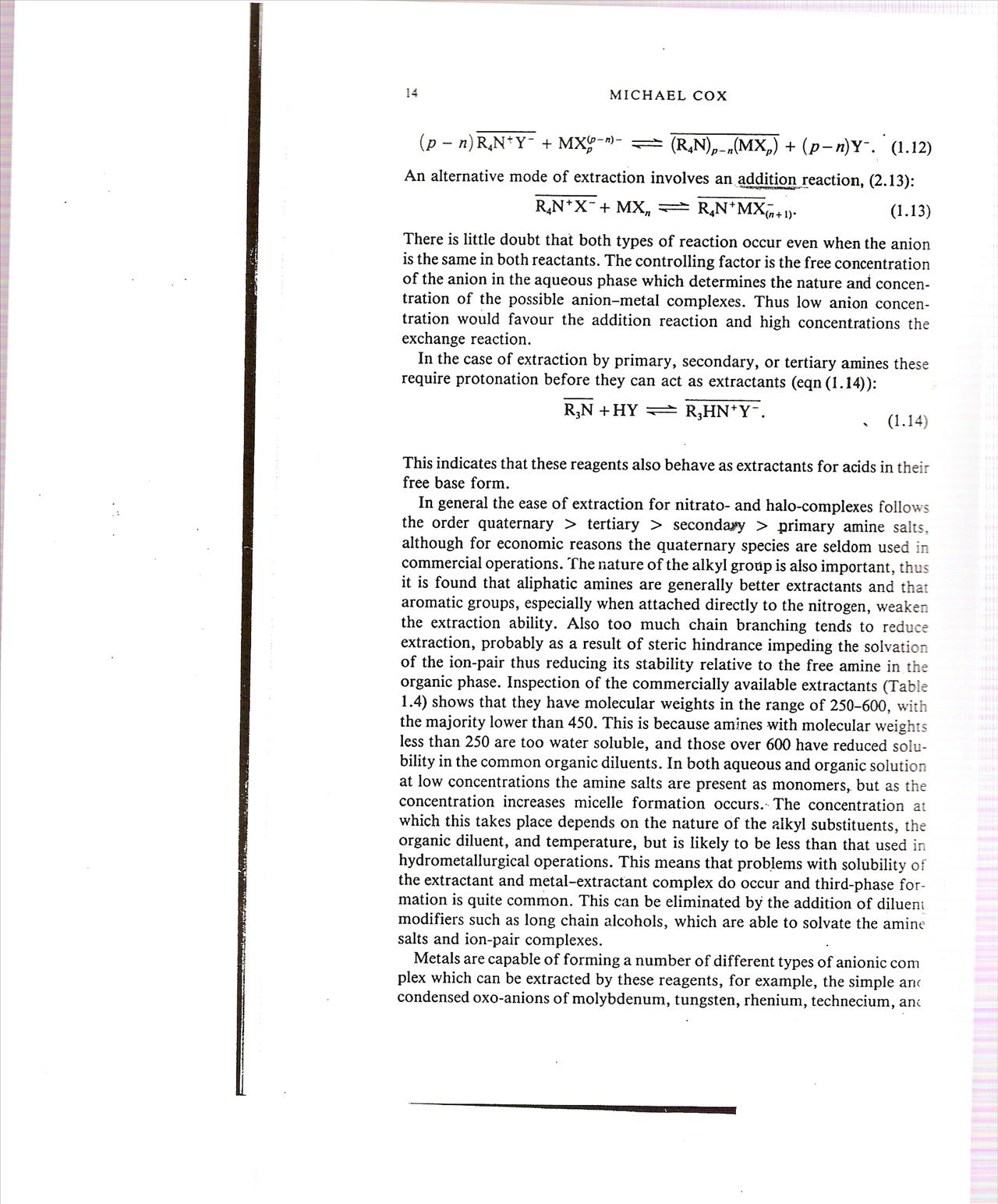scan0027 3

14 MICHAEL COX
(p - n) R4N* Y" + MXjT«- ^ (R4N)p.łł(MXp) + (p-n)Y\ * (1.12)
An alternative modę of extraction involves an addition reaction, (2.13):
R4N + X- + MX„ ^ R4N+MX(;+1). (1.13)
There is little doubt that both types of reaction occur even when the anion is the same in both reactants. The controlling factor is the free concentration of the anion in the aqueous phase which determines the naturę and concentration of the possible anion-metal complexes. Thus Iow anion concentration would favour the addition reaction and high concentrations the exchange reaction.
In the case of extraction by primary, secondary, or tertiary amines these require protonation before they can act as extractants (eqn(1.14)):
R^N +HY ^ R3HN+Y'. ^ (1 14)
This indicates that these reagents also behave as extractants for acids in their free base form.
In generał the ease of extraction for nitrato- and halo-complexes follows the order quaternary > tertiary > seconda/y > primary aminę salts. although for economic reasons the quaternary species are seldom used in commercial operations. The naturę of the alkyl group is also important, thus it is found that aliphatic amines are generally better extractants and tha: aromatic groups, especially when attached directly to the nitrogen, weaker. the extraction ability. Also too much chain branching tends to reduce extraction, probably as a result of steric hindrance impeding the solvation of the ion-pair thus reducing its stability relative to the free aminę in the organie phase. Inspection of the commercially available extractants (Tabie 1.4) shows that they have molecular weights in the rangę of 250-600, with the majority lower than 450. This is because amines with molecular weights less than 250 are too water soluble, and those over 600 have reduced solu-bility in the common organie diluents. In both aqueous and organie solution at Iow concentrations the aminę salts are present as monomers, but as the concentration inereases micelle formation occurs.-The concentration at which this takes place depends on the naturę of the alkyl substituents, the organie diluent, and temperaturę, but is likely to be less than that used in hydrometallurgical operations. This means that problems with solubility of the extractant and metal-extractant complex do occur and third-phase formation is quite common. This can be eliminated by the addition of dilueni modifiers such as long chain alcohols, which are able to solvate the amino salts and ion-pair complexes.
Metals are capable of forming a number of different types of anionie com plex which can be extracted by these reagents, for example, the simple anc condensed oxo-anions of molybdenum, tungsten, rhenium, technecium, anc
Wyszukiwarka
Podobne podstrony:
scan0031 4 18 MICHAEL COX 1.2.3 Solvating extractants In generał a soWating extractant tends to be r
scan0023 3 10 MICHAEL COX have an appreciable aqueous solubility, which can, under operating condi-t
scan0039 2 26 MICHAEL COX di-2-ethylhexylphosphoric acid. The presence of a third phase causes con-s
scan0041 2 28 MICHAEL COX For use as a diluent a liąuid should satisfy the following criteria: a wid
scan0043 2 30 MICHAEL COX hydrodynamic parameters but are difficult to set up and operate. Trouve et
scan0017 3 4 MICHAEL COX with extensive recycling, some impurities do build up in the process stream
scan0035 2 MICHAEL COX metal-extractant bonds are strongj morę specific reagents are required. As th
img052 (14) 9 kr Al ry fJU Q. -
SCAN0008 (14) " V a ,S0? Redutaa. N0X O cip u bcL^n lGEntstaubung RRiT ćoci~a~U paro
więcej podobnych podstron